Deck 3: Motion in Two and Three Dimensions
Question
Question
Question
Question
Question
Question
Question
Question
Question
Question
Question
Question
Question
Question
Question
Question
Question
Question
Question
Question
Question
Question
Question
Question
Question
Question
Question
Question
Question
Question
Question
Question
Question
Question
Question
Question
Question
Question
Question
Question
Question
Question
Question
Question
Question
Question
Question
Question
Question
Question
Question
Question
Question
Question
Question
Question
Question
Question
Question
Question
Question
Question
Question
Question
Question
Question
Question
Question
Question
Question
Question
Question
Question
Question
Question
Question
Question
Question
Question
Question

Unlock Deck
Sign up to unlock the cards in this deck!
Unlock Deck
Unlock Deck
1/94
Play
Full screen (f)
Deck 3: Motion in Two and Three Dimensions
1
The components of a vector  are Ax = -10 units and Ay = -6 units. What angle does this vector make with the positive x axis?
are Ax = -10 units and Ay = -6 units. What angle does this vector make with the positive x axis?
A) 31º
B) -31º
C) 180º - 31º
D) 180º + 31º
E) 90º - 31º
 are Ax = -10 units and Ay = -6 units. What angle does this vector make with the positive x axis?
are Ax = -10 units and Ay = -6 units. What angle does this vector make with the positive x axis?A) 31º
B) -31º
C) 180º - 31º
D) 180º + 31º
E) 90º - 31º
180º + 31º
2
The angle between vectors  and
and  is 30º, and
is 30º, and  . Which vector diagram correctly describes the vectors
. Which vector diagram correctly describes the vectors  ,
,  and
and  ?
? 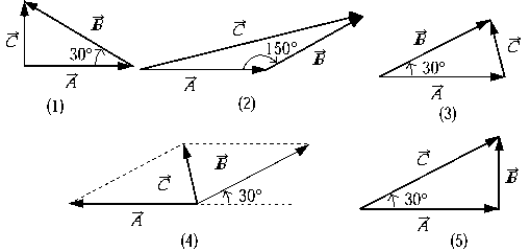
A) 1)
B) 2)
C) 3)
D) 4)
E) 5)
 and
and  is 30º, and
is 30º, and  . Which vector diagram correctly describes the vectors
. Which vector diagram correctly describes the vectors  ,
,  and
and  ?
? 
A) 1)
B) 2)
C) 3)
D) 4)
E) 5)
3)
3
Vector  has components Ax = +4.0 units and Ay = +3.2 units, whereas vector
has components Ax = +4.0 units and Ay = +3.2 units, whereas vector  has components Bx = +2.5 units and By = +5.5 units. The angle between the two vectors is
has components Bx = +2.5 units and By = +5.5 units. The angle between the two vectors is
A) 24º.
B) 65º.
C) 27º.
D) 39º.
E) 14º.
 has components Ax = +4.0 units and Ay = +3.2 units, whereas vector
has components Ax = +4.0 units and Ay = +3.2 units, whereas vector  has components Bx = +2.5 units and By = +5.5 units. The angle between the two vectors is
has components Bx = +2.5 units and By = +5.5 units. The angle between the two vectors isA) 24º.
B) 65º.
C) 27º.
D) 39º.
E) 14º.
27º.
4
The vector equation that describes the relationship among vectors  ,
,  , and
, and  is
is 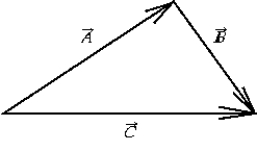
A) .
.
B) .
.
C) .
.
D) .
.
E) .
.
 ,
,  , and
, and  is
is 
A)
 .
.B)
 .
.C)
 .
.D)
 .
.E)
 .
.
Unlock Deck
Unlock for access to all 94 flashcards in this deck.
Unlock Deck
k this deck
5
Two vector quantities, whose directions can be altered at will, can have a resultant between the limits 5 and 15. The magnitudes of these two vector quantities could be
A) 2 and 2.
B) 5 and 10.
C) 20 and 40.
D) 20 and 50.
E) 59 and 97.
A) 2 and 2.
B) 5 and 10.
C) 20 and 40.
D) 20 and 50.
E) 59 and 97.

Unlock Deck
Unlock for access to all 94 flashcards in this deck.
Unlock Deck
k this deck
6
Three vectors,  ,
,  , and
, and  have the following x and y components:
have the following x and y components:  The magnitude of the resultant of
The magnitude of the resultant of  ,
,  , and
, and  is
is
A) 3.3.
B) 5.0.
C) 11.
D) 7.8.
E) 14.
 ,
,  , and
, and  have the following x and y components:
have the following x and y components:  The magnitude of the resultant of
The magnitude of the resultant of  ,
,  , and
, and  is
isA) 3.3.
B) 5.0.
C) 11.
D) 7.8.
E) 14.

Unlock Deck
Unlock for access to all 94 flashcards in this deck.
Unlock Deck
k this deck
7
Vectors  ,
,  , and
, and  have the following components, expressed in arbitrary units:
have the following components, expressed in arbitrary units:  Vector
Vector  is defined so that
is defined so that  = 0 The magnitude and direction of
= 0 The magnitude and direction of  relative to the positive x axis are
relative to the positive x axis are
A) 7.6 units at -26º.
B) 7.6 units at 154º.
C) 14 units at 26º.
D) 3.5 units at 29º.
E) 10 units at 29º.
 ,
,  , and
, and  have the following components, expressed in arbitrary units:
have the following components, expressed in arbitrary units:  Vector
Vector  is defined so that
is defined so that  = 0 The magnitude and direction of
= 0 The magnitude and direction of  relative to the positive x axis are
relative to the positive x axis areA) 7.6 units at -26º.
B) 7.6 units at 154º.
C) 14 units at 26º.
D) 3.5 units at 29º.
E) 10 units at 29º.

Unlock Deck
Unlock for access to all 94 flashcards in this deck.
Unlock Deck
k this deck
8
What is the least number of non-zero vectors that can be added to give a resultant equal to zero?
A) 2
B) 3
C) 4
D) 5
E) It cannot be done.
A) 2
B) 3
C) 4
D) 5
E) It cannot be done.

Unlock Deck
Unlock for access to all 94 flashcards in this deck.
Unlock Deck
k this deck
9
Which of the following vector equations correctly describes the relationship among the vectors shown in the figure below? 
A)
B)
C)
D)
E) None of these equations are correct.

A)

B)

C)

D)

E) None of these equations are correct.

Unlock Deck
Unlock for access to all 94 flashcards in this deck.
Unlock Deck
k this deck
10
The components of a vector  are Ax = -10 units and Ay = 6 units. What angle does this vector make with the positive x axis?
are Ax = -10 units and Ay = 6 units. What angle does this vector make with the positive x axis?
A) 31º
B) -31º
C) 180º - 31º
D) 180º + 31º
E) 90º - 31º
 are Ax = -10 units and Ay = 6 units. What angle does this vector make with the positive x axis?
are Ax = -10 units and Ay = 6 units. What angle does this vector make with the positive x axis?A) 31º
B) -31º
C) 180º - 31º
D) 180º + 31º
E) 90º - 31º

Unlock Deck
Unlock for access to all 94 flashcards in this deck.
Unlock Deck
k this deck
11
The vector in the figure below that could represent the vector  is
is 
A) .
.
B) .
.
C) .
.
D) .
.
E) .
.
 is
is 
A)
 .
.B)
 .
.C)
 .
.D)
 .
.E)
 .
.
Unlock Deck
Unlock for access to all 94 flashcards in this deck.
Unlock Deck
k this deck
12
Vectors  and
and  have the following components:
have the following components:  The angle between the negative x axis and the vector
The angle between the negative x axis and the vector  is
is
A) -45º.
B) 194º.
C) 37º.
D) -54º.
E) 86º.
 and
and  have the following components:
have the following components:  The angle between the negative x axis and the vector
The angle between the negative x axis and the vector  is
isA) -45º.
B) 194º.
C) 37º.
D) -54º.
E) 86º.

Unlock Deck
Unlock for access to all 94 flashcards in this deck.
Unlock Deck
k this deck
13
Vectors  and
and  have the following components:
have the following components:  The angle between the positive x axis and the vector
The angle between the positive x axis and the vector  is
is
A) -45º.
B) 194º.
C) 37º.
D) -54º.
E) 86º.
 and
and  have the following components:
have the following components:  The angle between the positive x axis and the vector
The angle between the positive x axis and the vector  is
isA) -45º.
B) 194º.
C) 37º.
D) -54º.
E) 86º.

Unlock Deck
Unlock for access to all 94 flashcards in this deck.
Unlock Deck
k this deck
14
Three vectors,  ,
,  , and
, and  have the following x and y components:
have the following x and y components:  The angle that the resultant makes with the positive direction of the x axis is
The angle that the resultant makes with the positive direction of the x axis is
A) 1.2º.
B) 36º.
C) 50º.
D) 40º.
E) 70º.
 ,
,  , and
, and  have the following x and y components:
have the following x and y components:  The angle that the resultant makes with the positive direction of the x axis is
The angle that the resultant makes with the positive direction of the x axis isA) 1.2º.
B) 36º.
C) 50º.
D) 40º.
E) 70º.

Unlock Deck
Unlock for access to all 94 flashcards in this deck.
Unlock Deck
k this deck
15
What is the least number of unequal non-zero vectors that can be added to give a resultant equal to zero?
A) 2
B) 3
C) 4
D) 5
E) It cannot be done.
A) 2
B) 3
C) 4
D) 5
E) It cannot be done.

Unlock Deck
Unlock for access to all 94 flashcards in this deck.
Unlock Deck
k this deck
16
Two vectors  and
and  are added to give a resultant
are added to give a resultant  . The components of
. The components of  are Ax = -8.0 units and Ay = 6.0 units, and the components of
are Ax = -8.0 units and Ay = 6.0 units, and the components of  are Bx = 1.0 units and By = -1.0 units. The magnitude of vector
are Bx = 1.0 units and By = -1.0 units. The magnitude of vector  is
is
A) -1.0 units.
B) +8.6 units.
C) +19 units.
D) +2.0 units.
E) -3.2 units.
 and
and  are added to give a resultant
are added to give a resultant  . The components of
. The components of  are Ax = -8.0 units and Ay = 6.0 units, and the components of
are Ax = -8.0 units and Ay = 6.0 units, and the components of  are Bx = 1.0 units and By = -1.0 units. The magnitude of vector
are Bx = 1.0 units and By = -1.0 units. The magnitude of vector  is
isA) -1.0 units.
B) +8.6 units.
C) +19 units.
D) +2.0 units.
E) -3.2 units.

Unlock Deck
Unlock for access to all 94 flashcards in this deck.
Unlock Deck
k this deck
17
Which of the following is NOT a vector?
A) velocity
B) acceleration
C) displacement
D) mass
E) force
A) velocity
B) acceleration
C) displacement
D) mass
E) force

Unlock Deck
Unlock for access to all 94 flashcards in this deck.
Unlock Deck
k this deck
18
The vector in the figure below that could represent the vector  is
is 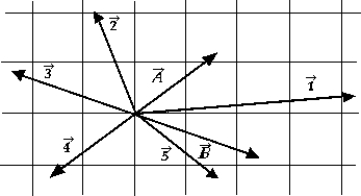
A) .
.
B) .
.
C) .
.
D) .
.
E) .
.
 is
is 
A)
 .
.B)
 .
.C)
 .
.D)
 .
.E)
 .
.
Unlock Deck
Unlock for access to all 94 flashcards in this deck.
Unlock Deck
k this deck
19
The angle between vectors  and
and  is 30º, and their sum is
is 30º, and their sum is  . Which vector diagram correctly describes the vectors
. Which vector diagram correctly describes the vectors  ,
,  and
and  ?
? 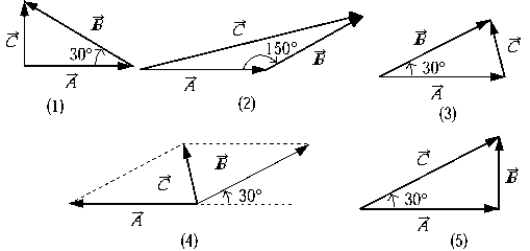
A) 1)
B) 2)
C) 3)
D) 4)
E) 5)
 and
and  is 30º, and their sum is
is 30º, and their sum is  . Which vector diagram correctly describes the vectors
. Which vector diagram correctly describes the vectors  ,
,  and
and  ?
? 
A) 1)
B) 2)
C) 3)
D) 4)
E) 5)

Unlock Deck
Unlock for access to all 94 flashcards in this deck.
Unlock Deck
k this deck
20
Two vector quantities, whose directions can be altered at will, can have a resultant of any magnitude between the limits 0 and 200. The magnitude of each vector quantity must therefore be
A) between 0 and 80.
B) between 120 and 200.
C) less than 100.
D) exactly 100.
E) more than 100.
A) between 0 and 80.
B) between 120 and 200.
C) less than 100.
D) exactly 100.
E) more than 100.

Unlock Deck
Unlock for access to all 94 flashcards in this deck.
Unlock Deck
k this deck
21
A vector A is shown below. The x and y components of the vector are, respectively, 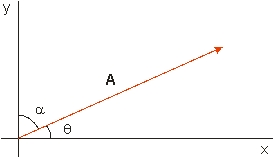
A) A sin , A cos ) or A sin , A cos ).
B) A sin , A cos ) or A cos , A sin ).
C) A sin , A sin ) or A sin , A cos ).
D) A cos , A cos ) or A sin , A cos ).
E) A cos , A cos ) or A cos , A cos ).

A) A sin , A cos ) or A sin , A cos ).
B) A sin , A cos ) or A cos , A sin ).
C) A sin , A sin ) or A sin , A cos ).
D) A cos , A cos ) or A sin , A cos ).
E) A cos , A cos ) or A cos , A cos ).

Unlock Deck
Unlock for access to all 94 flashcards in this deck.
Unlock Deck
k this deck
22
The components of four vectors are as follows:  The angle that the resultant vector makes with the positive x-axis is
The angle that the resultant vector makes with the positive x-axis is
A) -40º.
B) 59º.
C) -49.5º.
D) 37º.
E) -23º.
 The angle that the resultant vector makes with the positive x-axis is
The angle that the resultant vector makes with the positive x-axis isA) -40º.
B) 59º.
C) -49.5º.
D) 37º.
E) -23º.

Unlock Deck
Unlock for access to all 94 flashcards in this deck.
Unlock Deck
k this deck
23
The velocity vector of an object is given by  and 4 s later, its velocity vector is
and 4 s later, its velocity vector is  . The units are in m/s. The average acceleration vector,
. The units are in m/s. The average acceleration vector,  in m/s2 is
in m/s2 is
A) .
.
B) .
.
C) .
.
D) .
.
E) None of these is correct.
 and 4 s later, its velocity vector is
and 4 s later, its velocity vector is  . The units are in m/s. The average acceleration vector,
. The units are in m/s. The average acceleration vector,  in m/s2 is
in m/s2 isA)
 .
.B)
 .
.C)
 .
.D)
 .
.E) None of these is correct.

Unlock Deck
Unlock for access to all 94 flashcards in this deck.
Unlock Deck
k this deck
24
You walk 5 km north and then 12 km east. Your resultant displacement is
A) 13 km at an angle of 22.6º north of east.
B) 13 km at an angle of 67.4º north of east.
C) 17 km at an angle of 22.6º north of east.
D) 17 km at an angle of 67.4º north of east.
E) None of these is correct.
A) 13 km at an angle of 22.6º north of east.
B) 13 km at an angle of 67.4º north of east.
C) 17 km at an angle of 22.6º north of east.
D) 17 km at an angle of 67.4º north of east.
E) None of these is correct.

Unlock Deck
Unlock for access to all 94 flashcards in this deck.
Unlock Deck
k this deck
25
A velocity vector has an x component of +5.5 m/s and a y component of -3.5 m/s.  The diagram that gives the direction of the vector is
The diagram that gives the direction of the vector is
A) 1).
B) 2).
C) 3).
D) 4).
E) None of these is correct.
 The diagram that gives the direction of the vector is
The diagram that gives the direction of the vector isA) 1).
B) 2).
C) 3).
D) 4).
E) None of these is correct.

Unlock Deck
Unlock for access to all 94 flashcards in this deck.
Unlock Deck
k this deck
26
A velocity vector has an x component of -5.5 m/s and a y component of +3.5 m/s.  The diagram that gives the direction of the vector is
The diagram that gives the direction of the vector is
A) 1).
B) 2).
C) 3).
D) 4).
E) None of these is correct.
 The diagram that gives the direction of the vector is
The diagram that gives the direction of the vector isA) 1).
B) 2).
C) 3).
D) 4).
E) None of these is correct.

Unlock Deck
Unlock for access to all 94 flashcards in this deck.
Unlock Deck
k this deck
27
If an object is moving toward west, its acceleration
A) is directed towards north.
B) is directed towards east.
C) is directed towards west.
D) is directed towards south.
E) may be any direction.
A) is directed towards north.
B) is directed towards east.
C) is directed towards west.
D) is directed towards south.
E) may be any direction.

Unlock Deck
Unlock for access to all 94 flashcards in this deck.
Unlock Deck
k this deck
28
The velocity vector of an object is given by  and 4 s later, its velocity vector is
and 4 s later, its velocity vector is  . The units are in m/s. The magnitude of the change in the velocity vector
. The units are in m/s. The magnitude of the change in the velocity vector  is
is
A) 1.4 m/s.
B) 2.8 m/s.
C) 5.7m/s.
D) 3.7 m/s.
E) 11.3 m.
 and 4 s later, its velocity vector is
and 4 s later, its velocity vector is  . The units are in m/s. The magnitude of the change in the velocity vector
. The units are in m/s. The magnitude of the change in the velocity vector  is
isA) 1.4 m/s.
B) 2.8 m/s.
C) 5.7m/s.
D) 3.7 m/s.
E) 11.3 m.

Unlock Deck
Unlock for access to all 94 flashcards in this deck.
Unlock Deck
k this deck
29
Vectors  and
and  have the following components:
have the following components:  The magnitude of the vector
The magnitude of the vector  is
is
A) 6.3 units.
B) 10.0 units.
C) 2.8 units.
D) 8.2 units.
E) 16 units.
 and
and  have the following components:
have the following components:  The magnitude of the vector
The magnitude of the vector  is
isA) 6.3 units.
B) 10.0 units.
C) 2.8 units.
D) 8.2 units.
E) 16 units.

Unlock Deck
Unlock for access to all 94 flashcards in this deck.
Unlock Deck
k this deck
30
Three vectors  and
and  are added together. Which statement below best describes the additive property of the three vectors?
are added together. Which statement below best describes the additive property of the three vectors?
A)
B)
C)
D)
E) All of these
 and
and  are added together. Which statement below best describes the additive property of the three vectors?
are added together. Which statement below best describes the additive property of the three vectors?A)

B)

C)

D)

E) All of these

Unlock Deck
Unlock for access to all 94 flashcards in this deck.
Unlock Deck
k this deck
31
The velocity vector of an object is given by  and 4 s later, its velocity vector is
and 4 s later, its velocity vector is  . The units are in m/s. The angle that the change in the velocity vector
. The units are in m/s. The angle that the change in the velocity vector  makes with respect to the positive x-axis is given by
makes with respect to the positive x-axis is given by
A) .
.
B) .
.
C) .
.
D) .
.
E) None of these is correct.
 and 4 s later, its velocity vector is
and 4 s later, its velocity vector is  . The units are in m/s. The angle that the change in the velocity vector
. The units are in m/s. The angle that the change in the velocity vector  makes with respect to the positive x-axis is given by
makes with respect to the positive x-axis is given byA)
 .
.B)
 .
.C)
 .
.D)
 .
.E) None of these is correct.

Unlock Deck
Unlock for access to all 94 flashcards in this deck.
Unlock Deck
k this deck
32
Given vector  , the vector
, the vector 
A) has a magnitude 3 times that of .
.
B) points in the same direction as .
.
C) has components each of which is 3 times those of .
.
D) makes the same angle with a given axis as does .
.
E) is described by all of these.
 , the vector
, the vector 
A) has a magnitude 3 times that of
 .
.B) points in the same direction as
 .
.C) has components each of which is 3 times those of
 .
.D) makes the same angle with a given axis as does
 .
.E) is described by all of these.

Unlock Deck
Unlock for access to all 94 flashcards in this deck.
Unlock Deck
k this deck
33
A vector has an x component of 5.51 units and a y component of -9.52 units. The angle between the positive direction of the vector and the positive direction of the x-axis is approximately
A) 30o.
B) -30o.
C) 60o.
D) -60o.
E) None of these is correct.
A) 30o.
B) -30o.
C) 60o.
D) -60o.
E) None of these is correct.

Unlock Deck
Unlock for access to all 94 flashcards in this deck.
Unlock Deck
k this deck
34
A particle has an initial velocity of 4.8 m/s toward the south and a final velocity of 7.1 m/s toward the east. The particle was subject to a constant acceleration for 0.25 s. The magnitude and the direction of the acceleration must have been
A) 2.3 m/s2 at 34.1º north of east.
B) 8.6 m/s2 at 34.1º north of east.
C) 34 m/s2 at 34.1º north of east.
D) 34 m/s2 at 34.1º south of east.
E) 8.6 m/s2 at 34.1º south of east.
A) 2.3 m/s2 at 34.1º north of east.
B) 8.6 m/s2 at 34.1º north of east.
C) 34 m/s2 at 34.1º north of east.
D) 34 m/s2 at 34.1º south of east.
E) 8.6 m/s2 at 34.1º south of east.

Unlock Deck
Unlock for access to all 94 flashcards in this deck.
Unlock Deck
k this deck
35
The components of a vector
A) are not unique.
B) depend on the axes chosen.
C) can have one of the components equal to zero.
D) can be negative.
E) All are correct.
A) are not unique.
B) depend on the axes chosen.
C) can have one of the components equal to zero.
D) can be negative.
E) All are correct.

Unlock Deck
Unlock for access to all 94 flashcards in this deck.
Unlock Deck
k this deck
36
Vectors  ,
,  ,
,  , and
, and  have the following components:
have the following components:  The magnitude of the resultant is
The magnitude of the resultant is
A) - 4.6 units.
B) 5.4 units.
C) 29 units.
D) 3.5 units.
E) 7.3 units.
 ,
,  ,
,  , and
, and  have the following components:
have the following components:  The magnitude of the resultant is
The magnitude of the resultant isA) - 4.6 units.
B) 5.4 units.
C) 29 units.
D) 3.5 units.
E) 7.3 units.

Unlock Deck
Unlock for access to all 94 flashcards in this deck.
Unlock Deck
k this deck
37
A vector of magnitude 5 points in the +y direction. Another vector of magnitude 4 is subtracted from the first vector. The smallest possible magnitude of the sum is
A) 1.
B) 4.
C) 5.
D) 9.
E) 10.
A) 1.
B) 4.
C) 5.
D) 9.
E) 10.

Unlock Deck
Unlock for access to all 94 flashcards in this deck.
Unlock Deck
k this deck
38
What angle does the vector  = +5, -12) make with the positive x-axis?
= +5, -12) make with the positive x-axis?
A) 67.4º
B) 22.6º
C) 36.9º
D) 53.1º
E) 292.6º
 = +5, -12) make with the positive x-axis?
= +5, -12) make with the positive x-axis?A) 67.4º
B) 22.6º
C) 36.9º
D) 53.1º
E) 292.6º

Unlock Deck
Unlock for access to all 94 flashcards in this deck.
Unlock Deck
k this deck
39
A vector has an x component of -5.51 units and a y component of +9.52 units. The angle between the positive direction of the vector and the positive direction of the x-axis is
A) 125o.
B) 60o.
C) 120o.
D) 150o.
E) -60o.
A) 125o.
B) 60o.
C) 120o.
D) 150o.
E) -60o.

Unlock Deck
Unlock for access to all 94 flashcards in this deck.
Unlock Deck
k this deck
40
A vector of magnitude 5 points in the +y direction. Another vector of magnitude 4 is added to the first vector. The largest possible magnitude of the sum is
A) 1.
B) 4.
C) 5.
D) 9.
E) 10.
A) 1.
B) 4.
C) 5.
D) 9.
E) 10.

Unlock Deck
Unlock for access to all 94 flashcards in this deck.
Unlock Deck
k this deck
41
The position vector of an object is given by  and 4 s later, its position vector is
and 4 s later, its position vector is  . The units are in m. The magnitude of the change in the position vector
. The units are in m. The magnitude of the change in the position vector  is
is
A) 0 m.
B) m.
m.
C) m.
m.
D) 10 m.
E) m.
m.
 and 4 s later, its position vector is
and 4 s later, its position vector is  . The units are in m. The magnitude of the change in the position vector
. The units are in m. The magnitude of the change in the position vector  is
isA) 0 m.
B)
 m.
m.C)
 m.
m.D) 10 m.
E)
 m.
m.
Unlock Deck
Unlock for access to all 94 flashcards in this deck.
Unlock Deck
k this deck
42
A car is traveling south at 30 km/h. It rounds a curve, and 6 s later it is traveling west at 30 km/h. The magnitude of the average acceleration of the car is
A) zero.
B) 60 km/h · s.
C) 5 km/h · s.
D) 50 km/h · s.
E) 7.1 km/h · s.
A) zero.
B) 60 km/h · s.
C) 5 km/h · s.
D) 50 km/h · s.
E) 7.1 km/h · s.

Unlock Deck
Unlock for access to all 94 flashcards in this deck.
Unlock Deck
k this deck
43
The position vector of an object is given by  and 4 s later, its position vector is
and 4 s later, its position vector is  . The units are in m. The angle that the change in the position vector
. The units are in m. The angle that the change in the position vector  makes with respect to the positive x-axis is given by
makes with respect to the positive x-axis is given by
A) .
.
B) .
.
C) .
.
D) .
.
E) None of these is correct.
 and 4 s later, its position vector is
and 4 s later, its position vector is  . The units are in m. The angle that the change in the position vector
. The units are in m. The angle that the change in the position vector  makes with respect to the positive x-axis is given by
makes with respect to the positive x-axis is given byA)
 .
.B)
 .
.C)
 .
.D)
 .
.E) None of these is correct.

Unlock Deck
Unlock for access to all 94 flashcards in this deck.
Unlock Deck
k this deck
44
The position vector of an object is given by  and 4 s later, its position vector is
and 4 s later, its position vector is  . The units are in m. The average velocity vector,
. The units are in m. The average velocity vector,  in m/s is
in m/s is
A) .
.
B) .
.
C) .
.
D) .
.
E) None of these is correct.
 and 4 s later, its position vector is
and 4 s later, its position vector is  . The units are in m. The average velocity vector,
. The units are in m. The average velocity vector,  in m/s is
in m/s isA)
 .
.B)
 .
.C)
 .
.D)
 .
.E) None of these is correct.

Unlock Deck
Unlock for access to all 94 flashcards in this deck.
Unlock Deck
k this deck
45
The magnitude of the displacement of a particle is _______ the distance the particle has traveled.
A) larger than
B) smaller than
C) either larger or smaller than
D) the same as
E) smaller than or equal to
A) larger than
B) smaller than
C) either larger or smaller than
D) the same as
E) smaller than or equal to

Unlock Deck
Unlock for access to all 94 flashcards in this deck.
Unlock Deck
k this deck
46
The curve shows the position of an object with time. The object moves with a constant speed, v. 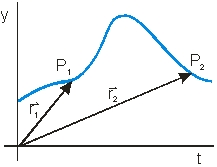 Which of the vector diagrams below best represent the change in velocity vector from P1 to P2?
Which of the vector diagrams below best represent the change in velocity vector from P1 to P2? 
A) 1)
B) 2)
C) 3)
D) 4)
E) None of these is correct.
 Which of the vector diagrams below best represent the change in velocity vector from P1 to P2?
Which of the vector diagrams below best represent the change in velocity vector from P1 to P2? 
A) 1)
B) 2)
C) 3)
D) 4)
E) None of these is correct.

Unlock Deck
Unlock for access to all 94 flashcards in this deck.
Unlock Deck
k this deck
47
A car is at position x1, y1) = 4 m, 5 m) at time t1 = 1 s. If 10 seconds later the car moving in a straight line is at position x2, y2) = 204 m, 305 m), find the size of the) component of the average velocity along the x-axis.
A) 30.0 m/s
B) 36.1 m/s
C) 20.0 m/s
D) 18.2 m/s
E) 22.2 m/s
A) 30.0 m/s
B) 36.1 m/s
C) 20.0 m/s
D) 18.2 m/s
E) 22.2 m/s

Unlock Deck
Unlock for access to all 94 flashcards in this deck.
Unlock Deck
k this deck
48
The position vector of an object is given by  and 4 s later, its position vector is
and 4 s later, its position vector is  . The units are in m. The change in the position vector
. The units are in m. The change in the position vector  , in m, is
, in m, is
A) .
.
B) .
.
C) .
.
D) .
.
E) None of these is correct.
 and 4 s later, its position vector is
and 4 s later, its position vector is  . The units are in m. The change in the position vector
. The units are in m. The change in the position vector  , in m, is
, in m, isA)
 .
.B)
 .
.C)
 .
.D)
 .
.E) None of these is correct.

Unlock Deck
Unlock for access to all 94 flashcards in this deck.
Unlock Deck
k this deck
49
A particle initially moving at 4.0 m/s along the x-axis is uniformly accelerated at 3.0 m/s2 along the y-axis for 2.0 s. The final speed of the particle is
A) -2.0 m/s.
B) 8.2 m/s.
C) 6.0 m/s.
D) 10 m/s.
E) None of these is correct.
A) -2.0 m/s.
B) 8.2 m/s.
C) 6.0 m/s.
D) 10 m/s.
E) None of these is correct.

Unlock Deck
Unlock for access to all 94 flashcards in this deck.
Unlock Deck
k this deck
50
The distance traveled by a particle is _______ the magnitude of the displacement of the particle.
A) larger than or equal to
B) smaller than
C) either larger or smaller than
D) the same as
E) smaller than or equal to
A) larger than or equal to
B) smaller than
C) either larger or smaller than
D) the same as
E) smaller than or equal to

Unlock Deck
Unlock for access to all 94 flashcards in this deck.
Unlock Deck
k this deck
51
A car is at position x1, y1) = 4 m, 5 m) at time t1 = 1 s. If 10 seconds later the car moving in a straight line is at position x2, y2) = 204 m, 305 m), calculate the distance traveled by the car in this interval.
A) 367 m
B) 500 m
C) 373 m
D) 509 m
E) 361 m
A) 367 m
B) 500 m
C) 373 m
D) 509 m
E) 361 m

Unlock Deck
Unlock for access to all 94 flashcards in this deck.
Unlock Deck
k this deck
52
The initial path of a rocket is 30° above the horizontal, and the horizontal component of the rocket's velocity is 326 m/s. The initial vertical component of the rocket's velocity is
A) 188 m/s.
B) 330 m/s.
C) 380 m/s.
D) 280 m/s.
E) 250 m/s.
A) 188 m/s.
B) 330 m/s.
C) 380 m/s.
D) 280 m/s.
E) 250 m/s.

Unlock Deck
Unlock for access to all 94 flashcards in this deck.
Unlock Deck
k this deck
53
A car proceeding due south at 60 km/h  ) makes a right turn, after which it is traveling due west at 80 km/h
) makes a right turn, after which it is traveling due west at 80 km/h  ).
). 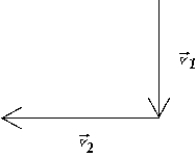 What is its change in velocity
What is its change in velocity  )?
)?
A) 100 km/h 37º north of west
B) 100 km/h 37º south of west
C) 20 km/h west
D) 20 km/h 37º north of west
E) 20 km/h 37º south of west
 ) makes a right turn, after which it is traveling due west at 80 km/h
) makes a right turn, after which it is traveling due west at 80 km/h  ).
).  What is its change in velocity
What is its change in velocity  )?
)?A) 100 km/h 37º north of west
B) 100 km/h 37º south of west
C) 20 km/h west
D) 20 km/h 37º north of west
E) 20 km/h 37º south of west

Unlock Deck
Unlock for access to all 94 flashcards in this deck.
Unlock Deck
k this deck
54
A particle initially moving at 4.0 m/s along the y-axis is uniformly accelerated at 3.0 m/s2 along the x-axis for 2.0 s. The final speed of the particle is
A) -2.0 m/s.
B) 7.2 m/s.
C) 6.0 m/s.
D) 10 m/s.
E) None of these is correct.
A) -2.0 m/s.
B) 7.2 m/s.
C) 6.0 m/s.
D) 10 m/s.
E) None of these is correct.

Unlock Deck
Unlock for access to all 94 flashcards in this deck.
Unlock Deck
k this deck
55
A car is at position x1, y1) = 4 m, 5 m) at time t1 = 1 s. If 10 seconds later the car moving in a straight line is at position x2, y2) = 204 m, 305 m), calculate the magnitude of the average velocity during this interval.
A) 36.1 m/s
B) 32.8 m/s
C) 36.7 m/s
D) 50.0 m/s
E) 40.1 m/s
A) 36.1 m/s
B) 32.8 m/s
C) 36.7 m/s
D) 50.0 m/s
E) 40.1 m/s

Unlock Deck
Unlock for access to all 94 flashcards in this deck.
Unlock Deck
k this deck
56
A car is traveling east at 50 km/h. It rounds a curve, and 5 s later it is traveling north at 50 km/h. The magnitude of the average acceleration of the car is
A) zero.
B) 20 km/h · s.
C) 10 km/h · s.
D) 50 km/h · s.
E) None of these is correct.
A) zero.
B) 20 km/h · s.
C) 10 km/h · s.
D) 50 km/h · s.
E) None of these is correct.

Unlock Deck
Unlock for access to all 94 flashcards in this deck.
Unlock Deck
k this deck
57
The curve shows the position of an object with time. The object moves with a constant speed, v. 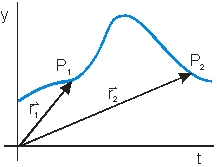 Which of the vector diagrams below best represent the change in position vector from P1 to P2?
Which of the vector diagrams below best represent the change in position vector from P1 to P2? 
A) 1)
B) 2)
C) 3)
D) 4)
E) None of these is correct.
 Which of the vector diagrams below best represent the change in position vector from P1 to P2?
Which of the vector diagrams below best represent the change in position vector from P1 to P2? 
A) 1)
B) 2)
C) 3)
D) 4)
E) None of these is correct.

Unlock Deck
Unlock for access to all 94 flashcards in this deck.
Unlock Deck
k this deck
58
You walk 12 km south and then 5 km east. Your resultant displacement is
A) 13 km at an angle of 22.6º south of east.
B) 13 km at an angle of 67.4º south of east.
C) 17 km at an angle of 22.6º south of east.
D) 17 km at an angle of 67.4º south of east.
E) None of these is correct.
A) 13 km at an angle of 22.6º south of east.
B) 13 km at an angle of 67.4º south of east.
C) 17 km at an angle of 22.6º south of east.
D) 17 km at an angle of 67.4º south of east.
E) None of these is correct.

Unlock Deck
Unlock for access to all 94 flashcards in this deck.
Unlock Deck
k this deck
59
A projectile is fired at an angle of 45° above the horizontal. 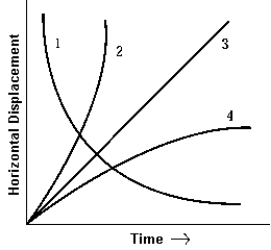 If air resistance is neglected, the line in the graph that best represents the horizontal displacement of the projectile as a function of travel time is
If air resistance is neglected, the line in the graph that best represents the horizontal displacement of the projectile as a function of travel time is
A) 1.
B) 2.
C) 3.
D) 4.
E) None of these is correct.
 If air resistance is neglected, the line in the graph that best represents the horizontal displacement of the projectile as a function of travel time is
If air resistance is neglected, the line in the graph that best represents the horizontal displacement of the projectile as a function of travel time isA) 1.
B) 2.
C) 3.
D) 4.
E) None of these is correct.

Unlock Deck
Unlock for access to all 94 flashcards in this deck.
Unlock Deck
k this deck
60
The curve shows the position of an object with time. The object moves with a constant speed, v. 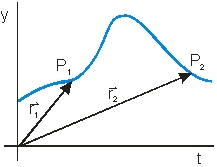 Which of the vector diagrams below best represent the velocity vector at P1 and P2?
Which of the vector diagrams below best represent the velocity vector at P1 and P2? 
A) 1)
B) 2)
C) 3)
D) 4)
E) None of these is correct.
 Which of the vector diagrams below best represent the velocity vector at P1 and P2?
Which of the vector diagrams below best represent the velocity vector at P1 and P2? 
A) 1)
B) 2)
C) 3)
D) 4)
E) None of these is correct.

Unlock Deck
Unlock for access to all 94 flashcards in this deck.
Unlock Deck
k this deck
61
The figure represents the parabolic trajectory of a ball going from a to e in Earth gravity but without air resistance. The initial velocity of the ball is Vo at an angle to the horizon. The vertical dashed lines represent equal time interval, t. 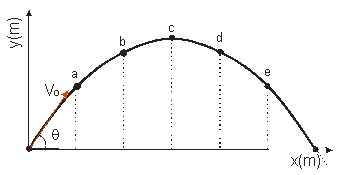 The acceleration at point a is ____ the acceleration at c.
The acceleration at point a is ____ the acceleration at c.
A) less than
B) equal to
C) greater than
D) Unable to tell.
E) Depends on how g changes along the path.
 The acceleration at point a is ____ the acceleration at c.
The acceleration at point a is ____ the acceleration at c.A) less than
B) equal to
C) greater than
D) Unable to tell.
E) Depends on how g changes along the path.

Unlock Deck
Unlock for access to all 94 flashcards in this deck.
Unlock Deck
k this deck
62
Which of the following statements is not true of a projectile moving against negligible air resistance near the surface of Earth?
A) The horizontal velocity is constant.
B) The vertical acceleration is constant.
C) The horizontal displacement is directly proportional to the time of flight.
D) The vertical velocity at any given time is independent of the angle of projection.
E) The horizontal acceleration is constant.
A) The horizontal velocity is constant.
B) The vertical acceleration is constant.
C) The horizontal displacement is directly proportional to the time of flight.
D) The vertical velocity at any given time is independent of the angle of projection.
E) The horizontal acceleration is constant.

Unlock Deck
Unlock for access to all 94 flashcards in this deck.
Unlock Deck
k this deck
63
The maximum horizontal range of a rock that is thrown at the same speed but different angles with the horizon and that lands at a level, H, below the initial level occurs when the angle is
A) less than 0 .
B) 0 .
C) greater than 0 and less than 45 actual value depends on the value of H).
D) 45 ,
E) greater than 45 .
A) less than 0 .
B) 0 .
C) greater than 0 and less than 45 actual value depends on the value of H).
D) 45 ,
E) greater than 45 .

Unlock Deck
Unlock for access to all 94 flashcards in this deck.
Unlock Deck
k this deck
64
The figure represents the parabolic trajectory of a ball going from A to E in Earth gravity but without air resistance. 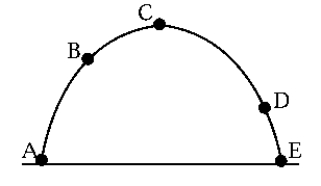 At point C the velocity of the ball is
At point C the velocity of the ball is
A) a maximum and is directed to the right.
B) directed to the left.
C) a maximum.
D) a minimum and is directed to the right.
E) zero.
 At point C the velocity of the ball is
At point C the velocity of the ball isA) a maximum and is directed to the right.
B) directed to the left.
C) a maximum.
D) a minimum and is directed to the right.
E) zero.

Unlock Deck
Unlock for access to all 94 flashcards in this deck.
Unlock Deck
k this deck
65
The figure represents the parabolic trajectory of a ball going from a to e in Earth gravity but without air resistance. The initial velocity of the ball is Vo at an angle to the horizon. The vertical dashed lines represent equal time interval, t. Consider "up" as the positive direction. ![<strong>The figure represents the parabolic trajectory of a ball going from a to e in Earth gravity but without air resistance. The initial velocity of the ball is V<sub>o</sub> at an angle \theta to the horizon. The vertical dashed lines represent equal time interval, \Delta t. Consider up as the positive direction. The vertical velocity at point b is [Note: g = 9.81 m/s<sup>2</sup>)]</strong> A) 0. B) V<sub>o</sub> cos \theta ) - ½ g 2 \Delta t)<sup>2</sup>. C) V<sub>o</sub> sin \theta ) - ½ g 2 \Delta t)<sup>2</sup>. D) V<sub>o</sub> sin \theta ) + ½ g 2 \Delta t)<sup>2</sup>. E) V<sub>o</sub> cos \theta ) + ½ g 2 \Delta t)<sup>2</sup>.](https://d2lvgg3v3hfg70.cloudfront.net/TB7291/11eb1367_516c_dcad_8021_43687a4434ad_TB7291_00.jpg) The vertical velocity at point b is [Note: g = 9.81 m/s2)]
The vertical velocity at point b is [Note: g = 9.81 m/s2)]
A) 0.
B) Vo cos ) - ½ g 2 t)2.
C) Vo sin ) - ½ g 2 t)2.
D) Vo sin ) + ½ g 2 t)2.
E) Vo cos ) + ½ g 2 t)2.
![<strong>The figure represents the parabolic trajectory of a ball going from a to e in Earth gravity but without air resistance. The initial velocity of the ball is V<sub>o</sub> at an angle \theta to the horizon. The vertical dashed lines represent equal time interval, \Delta t. Consider up as the positive direction. The vertical velocity at point b is [Note: g = 9.81 m/s<sup>2</sup>)]</strong> A) 0. B) V<sub>o</sub> cos \theta ) - ½ g 2 \Delta t)<sup>2</sup>. C) V<sub>o</sub> sin \theta ) - ½ g 2 \Delta t)<sup>2</sup>. D) V<sub>o</sub> sin \theta ) + ½ g 2 \Delta t)<sup>2</sup>. E) V<sub>o</sub> cos \theta ) + ½ g 2 \Delta t)<sup>2</sup>.](https://d2lvgg3v3hfg70.cloudfront.net/TB7291/11eb1367_516c_dcad_8021_43687a4434ad_TB7291_00.jpg) The vertical velocity at point b is [Note: g = 9.81 m/s2)]
The vertical velocity at point b is [Note: g = 9.81 m/s2)]A) 0.
B) Vo cos ) - ½ g 2 t)2.
C) Vo sin ) - ½ g 2 t)2.
D) Vo sin ) + ½ g 2 t)2.
E) Vo cos ) + ½ g 2 t)2.

Unlock Deck
Unlock for access to all 94 flashcards in this deck.
Unlock Deck
k this deck
66
A plane is flying horizontally at a height of 500 m and a constant speed of 429 km/h when an object is projected vertically downward at an initial speed of 35.0 m/s. If air resistance is neglected, the average vertical component of velocity between the object's release and its striking the ground is
A) 70.0 m/s.
B) 5.50 * 103 m/s.
C) 140 m/s.
D) 105 m/s.
E) 35.0 m/s.
A) 70.0 m/s.
B) 5.50 * 103 m/s.
C) 140 m/s.
D) 105 m/s.
E) 35.0 m/s.

Unlock Deck
Unlock for access to all 94 flashcards in this deck.
Unlock Deck
k this deck
67
The figure represents the parabolic trajectory of a ball going from a to e in Earth gravity but without air resistance. The initial velocity of the ball is Vo at an angle to the horizon. The vertical dashed lines represent equal time interval, t. Consider UP as the positive direction. ![<strong>The figure represents the parabolic trajectory of a ball going from a to e in Earth gravity but without air resistance. The initial velocity of the ball is V<sub>o</sub> at an angle \theta to the horizon. The vertical dashed lines represent equal time interval, \Delta t. Consider UP as the positive direction. The vertical velocity at point c is [Note: g = 9.81 m/s<sup>2</sup>)]</strong> A) V<sub>o</sub> cos \theta ). B) V<sub>o</sub> cos \theta ) - ½ g 3 \Delta t)<sup>2</sup>. C) V<sub>o</sub> sin \theta ) - ½ g 3 \Delta t)<sup>2</sup>. D) 0. E) V<sub>o</sub> cos \theta ) + ½ g 3 \Delta t)<sup>2</sup>.](https://d2lvgg3v3hfg70.cloudfront.net/TB7291/11eb1367_516c_dcaf_8021_6f77206b5731_TB7291_00.jpg) The vertical velocity at point c is [Note: g = 9.81 m/s2)]
The vertical velocity at point c is [Note: g = 9.81 m/s2)]
A) Vo cos ).
B) Vo cos ) - ½ g 3 t)2.
C) Vo sin ) - ½ g 3 t)2.
D) 0.
E) Vo cos ) + ½ g 3 t)2.
![<strong>The figure represents the parabolic trajectory of a ball going from a to e in Earth gravity but without air resistance. The initial velocity of the ball is V<sub>o</sub> at an angle \theta to the horizon. The vertical dashed lines represent equal time interval, \Delta t. Consider UP as the positive direction. The vertical velocity at point c is [Note: g = 9.81 m/s<sup>2</sup>)]</strong> A) V<sub>o</sub> cos \theta ). B) V<sub>o</sub> cos \theta ) - ½ g 3 \Delta t)<sup>2</sup>. C) V<sub>o</sub> sin \theta ) - ½ g 3 \Delta t)<sup>2</sup>. D) 0. E) V<sub>o</sub> cos \theta ) + ½ g 3 \Delta t)<sup>2</sup>.](https://d2lvgg3v3hfg70.cloudfront.net/TB7291/11eb1367_516c_dcaf_8021_6f77206b5731_TB7291_00.jpg) The vertical velocity at point c is [Note: g = 9.81 m/s2)]
The vertical velocity at point c is [Note: g = 9.81 m/s2)]A) Vo cos ).
B) Vo cos ) - ½ g 3 t)2.
C) Vo sin ) - ½ g 3 t)2.
D) 0.
E) Vo cos ) + ½ g 3 t)2.

Unlock Deck
Unlock for access to all 94 flashcards in this deck.
Unlock Deck
k this deck
68
A projectile was fired at 35º above the horizontal. At the highest point in its trajectory its speed was 200 m/s. If air resistance is ignored, the initial velocity had a horizontal component of
A) zero.
B) 200 cos 35º) m/s.
C) 200 sin 35º) m/s.
D) 200/cos 35º) m/s.
E) 200 m/s.
A) zero.
B) 200 cos 35º) m/s.
C) 200 sin 35º) m/s.
D) 200/cos 35º) m/s.
E) 200 m/s.

Unlock Deck
Unlock for access to all 94 flashcards in this deck.
Unlock Deck
k this deck
69
A projectile is fired horizontally from the top of a building in Earth gravity with an initial speed v0. 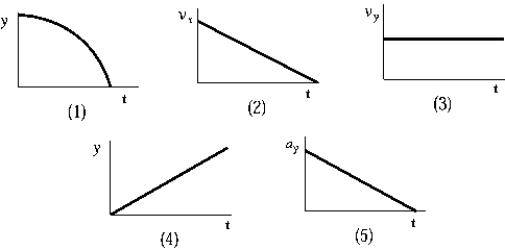 In the absence of air resistance, which of the graphs is representative of the projectile's motion?
In the absence of air resistance, which of the graphs is representative of the projectile's motion?
A) 1)
B) 2)
C) 3)
D) 4)
E) 5)
 In the absence of air resistance, which of the graphs is representative of the projectile's motion?
In the absence of air resistance, which of the graphs is representative of the projectile's motion?A) 1)
B) 2)
C) 3)
D) 4)
E) 5)

Unlock Deck
Unlock for access to all 94 flashcards in this deck.
Unlock Deck
k this deck
70
If a baseball is thrown at an angle of elevation of 30°, its range in the absence of air resistance is less than that of one thrown at
A) 0º.
B) 80º.
C) 20º.
D) 55º.
E) 90º.
A) 0º.
B) 80º.
C) 20º.
D) 55º.
E) 90º.

Unlock Deck
Unlock for access to all 94 flashcards in this deck.
Unlock Deck
k this deck
71
The figure represents the parabolic trajectory of a ball going from a to e in Earth gravity but without air resistance. The initial velocity of the ball is Vo at an angle to the horizon. The vertical dashed lines represent equal time interval, t. 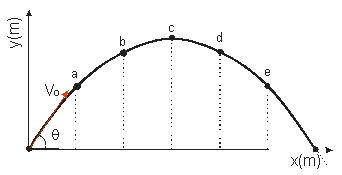 The horizontal velocity at point c is
The horizontal velocity at point c is
A) 0.
B) Vo cos ).
C) Vo sin ).
D) Vo.
E) depends on what g is along the path.
 The horizontal velocity at point c is
The horizontal velocity at point c isA) 0.
B) Vo cos ).
C) Vo sin ).
D) Vo.
E) depends on what g is along the path.

Unlock Deck
Unlock for access to all 94 flashcards in this deck.
Unlock Deck
k this deck
72
If you ignore air resistance in projectile motion, the ________ of the projectile remains constant.
A) velocity vector
B) horizontal component of the velocity vector
C) vertical component of the velocity vector
D) speed
E) range
A) velocity vector
B) horizontal component of the velocity vector
C) vertical component of the velocity vector
D) speed
E) range

Unlock Deck
Unlock for access to all 94 flashcards in this deck.
Unlock Deck
k this deck
73
A golfer drives her ball from the tee down the fairway in a high arcing shot. When the ball is at the highest point of its flight,
A) its velocity and acceleration are both zero.
B) its velocity is zero but its acceleration is nonzero.
C) its velocity is nonzero but its acceleration is zero.
D) its velocity and acceleration are both nonzero.
E) Insufficient information is given to answer correctly.
A) its velocity and acceleration are both zero.
B) its velocity is zero but its acceleration is nonzero.
C) its velocity is nonzero but its acceleration is zero.
D) its velocity and acceleration are both nonzero.
E) Insufficient information is given to answer correctly.

Unlock Deck
Unlock for access to all 94 flashcards in this deck.
Unlock Deck
k this deck
74
A projectile is fired with an initial speed of 1000 m/s at an angle of 37° above the horizontal. If air resistance is neglected, the horizontal component of the projectile's velocity after 20 s is approximately
A) 600 m/s.
B) 800 m/s.
C) 640 m/s.
D) 40 m/s,
E) 160 m/s.
A) 600 m/s.
B) 800 m/s.
C) 640 m/s.
D) 40 m/s,
E) 160 m/s.

Unlock Deck
Unlock for access to all 94 flashcards in this deck.
Unlock Deck
k this deck
75
A baseball is thrown with a velocity  at an angle with the horizontal. The horizontal component of its velocity in the absence of air resistance is
at an angle with the horizontal. The horizontal component of its velocity in the absence of air resistance is
A) v cos
B) v cos - gt.
C) v2 + 2gx.
D) v2 - 2gx.
E) v sin - gt.
 at an angle with the horizontal. The horizontal component of its velocity in the absence of air resistance is
at an angle with the horizontal. The horizontal component of its velocity in the absence of air resistance isA) v cos
B) v cos - gt.
C) v2 + 2gx.
D) v2 - 2gx.
E) v sin - gt.

Unlock Deck
Unlock for access to all 94 flashcards in this deck.
Unlock Deck
k this deck
76
The figure represents the parabolic trajectory of a ball going from A to E in Earth gravity but without air resistance. 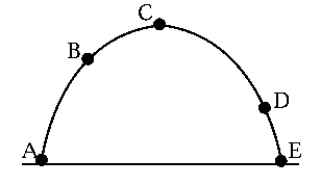 What is the direction of the acceleration at point C?
What is the direction of the acceleration at point C?
A) It is to the right.
B) It is to the left.
C) It is straight up.
D) It is straight down.
E) The acceleration of the ball is zero.
 What is the direction of the acceleration at point C?
What is the direction of the acceleration at point C?A) It is to the right.
B) It is to the left.
C) It is straight up.
D) It is straight down.
E) The acceleration of the ball is zero.

Unlock Deck
Unlock for access to all 94 flashcards in this deck.
Unlock Deck
k this deck
77
You shoot an arrow in a high arc toward a target located some distance away. At the highest point in its flight, the arrow's
A) velocity and acceleration are both nonzero.
B) velocity is zero but its acceleration is nonzero.
C) velocity is nonzero but its acceleration is zero.
D) velocity and acceleration are both zero.
E) Insufficient information is given to answer correctly.
A) velocity and acceleration are both nonzero.
B) velocity is zero but its acceleration is nonzero.
C) velocity is nonzero but its acceleration is zero.
D) velocity and acceleration are both zero.
E) Insufficient information is given to answer correctly.

Unlock Deck
Unlock for access to all 94 flashcards in this deck.
Unlock Deck
k this deck
78
A projectile is shot at an angle of 45º to the horizontal near the surface of Earth but in the absence of air resistance. When it reaches the highest point of its trajectory, its speed is 150 m/s. In a second trial with the same projectile, the initial speed is the same but the angle is now 37º with the horizontal. At its highest point in this trajectory, the speed of the projectile would be
A) 150 m/s sin 45º/sin 36º).
B) 150 m/s cos 37º/cos 45º).
C) 150 m/s sin 37º/sin 45º).
D) 150 m/s (37/45).
E) None of these is correct.
A) 150 m/s sin 45º/sin 36º).
B) 150 m/s cos 37º/cos 45º).
C) 150 m/s sin 37º/sin 45º).
D) 150 m/s (37/45).
E) None of these is correct.

Unlock Deck
Unlock for access to all 94 flashcards in this deck.
Unlock Deck
k this deck
79
The figure represents the parabolic trajectory of a ball going from A to E in Earth gravity but without air resistance. 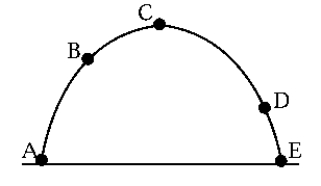 What is the direction of the acceleration at point B?
What is the direction of the acceleration at point B?
A) It is up and to the right.
B) It is down and to the left.
C) It is straight up.
D) It is straight down.
E) The acceleration of the ball is zero.
 What is the direction of the acceleration at point B?
What is the direction of the acceleration at point B?A) It is up and to the right.
B) It is down and to the left.
C) It is straight up.
D) It is straight down.
E) The acceleration of the ball is zero.

Unlock Deck
Unlock for access to all 94 flashcards in this deck.
Unlock Deck
k this deck
80
A rescue airplane is diving at an angle of 37º below the horizontal with a speed of 250 m/s. It releases a survival package when it is at an altitude of 600 m. If air resistance is ignored, the horizontal distance of the point of impact from the plane at the moment of the package's release is
A) 2.80 * 103 m.
B) 720 m.
C) 6.80 * 103 m.
D) 420 m.
E) 5.50 * 103 m.
A) 2.80 * 103 m.
B) 720 m.
C) 6.80 * 103 m.
D) 420 m.
E) 5.50 * 103 m.

Unlock Deck
Unlock for access to all 94 flashcards in this deck.
Unlock Deck
k this deck



